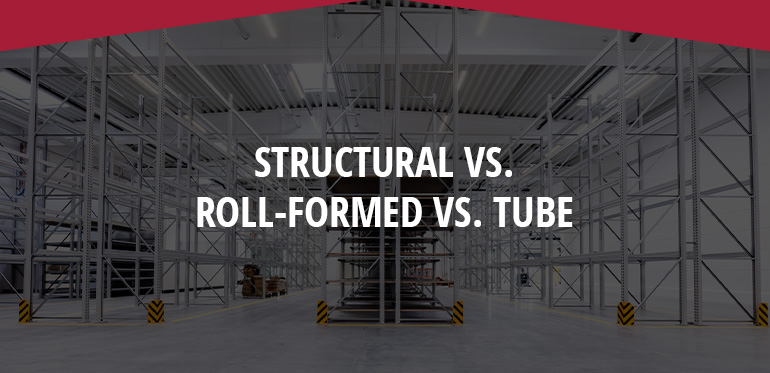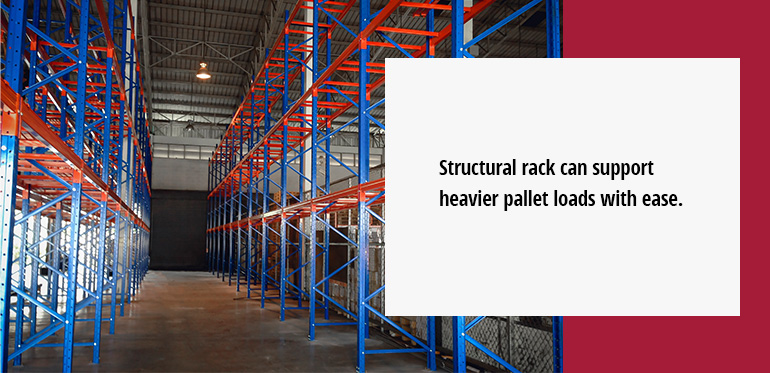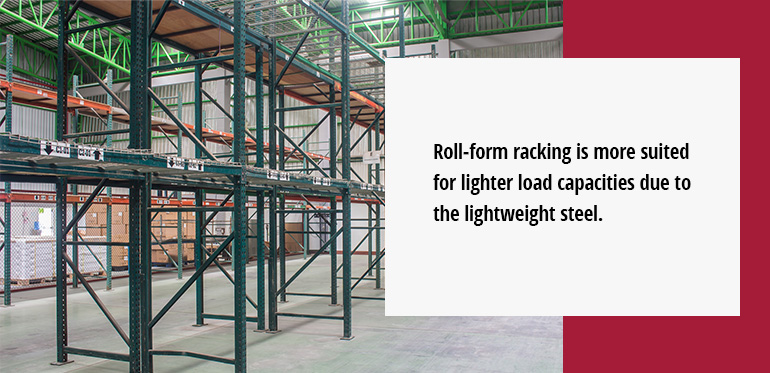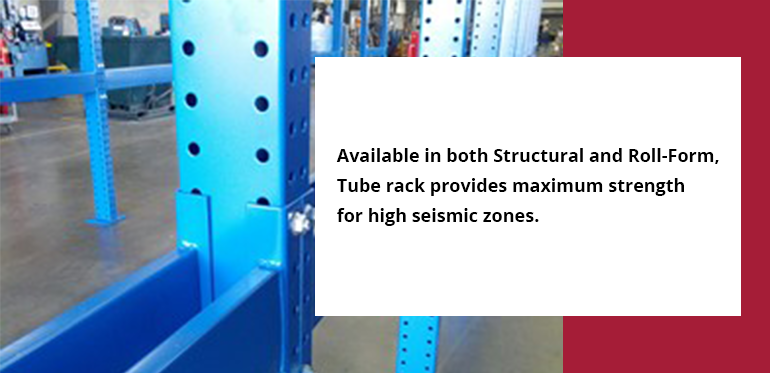
03 Oct Structural vs. Roll-Formed vs. Tube
Pallet racking systems are essential for warehouse efficiency. Available in various configurations, they improve storage density and increase the productivity of warehouse operations.
As companies look to invest in new pallet racking systems, it’s helpful to understand variations in materials. While working with manufacturers, distributors and installers, knowing the different available materials can help make the process easier.
Pallet racking systems are available in three major construction materials: structural steel racking, roll-form racking and tube racking. Each option has unique benefits and can suit particular applications. Understanding these differences can help managers better understand their options when looking for the best type of rack for their warehouse.
Learn about the difference between structural, roll-formed and tube racking and how to know which is best for specific warehouse needs.
What Is Structural Racking?
Structural racking is a popular material option for pallet racking systems. Steel mills pass raw iron through a series of forming rollers at high temperatures into low-gauge, high-strength steel components, typically open C channel and angle profiles. Racking fabricators then cut, punch, weld and form the components into beams and frame assemblies, which are then bolted together during installation to create a high-quality, sturdy steel structure.
Structural steel is durable and heavy-duty, able to manage large loads and endure rough conditions. They are often used in high-volume forklift facilities and warehouses with fast-paced environments. Structural steel is also found in rack types used in heavy-use environments, such as:
- Drive In: Drive in racking focuses on storage optimization, making maximum use of floor and height space. Structural racks accommodate the frequent maneuvering of trucks throughout the bays.
- Push Back: Push back systems allow for deep storage for two to five pallets at a time.
- Pallet Flow: This system design features sloped shelves with rollers, allowing for easy picking.
Pros of Structural Racking
To understand which environments structural racking is best suited for, it’s best to consider its specific benefits.
Structural racking has many advantages for warehouses, including:
- Impact resistance: The bolted connections of structural racking systems allow for greater impact resistance than other systems. Due to its strong structural integrity, this option is more resistant to impact from lift trucks when compared to Roll-Form racking. Structural racks’ durability creates a long-term solution, lowering the need for frequent replacements.
- Higher capacity shelves: Because of its bolted construction and higher strength, structural rack can support heavier pallet loads with ease.
- Many applications: Structural racks can be implemented in many warehouse configurations and applications. For instance, they are frequently used in cold storage facilities. Their frame strength allows them to withstand cold conditions or other harsh environments.
What Is Roll-Form Racking?
Roll-form racking is made using a cold-rolling process. This method consists of running coils of lower gauge steel through a series of metal roll forming machines at room temperature to create higher gauge, thin steel components into desired shapes. Professional installers drop the beams into slots and secure the steel beams to uprights with safety locking clips to form the final system.
Roll-form racking is well suited for lighter load capacities due to the lighter weight, higher gauge construction. These systems are easier than other systems to install and disassemble, making it easier to adjust to organizational changes. Before making any changes to the rack configuration, obtain approval of proposed layouts with the rack manufacturer or supplier to ensure the structural integrity of your system.
Pros of Roll-Form Racking
Roll-form racking has various benefits for warehouses. Some of the pros include:
- Cost-effective: The parts in roll-form racking can be more cost-effective than structural racking parts. Roll-form consists of higher gauge steel, which is thinner than other types. Because less steel is needed to manufacture the rack, the systems often cost less for warehouses.
- Installation: In addition to the lower cost of material and freight due to lower weights, roll form racking is easier and more cost effective to install than structural racking. Beams are dropped into slots in an upright frame and locked into place with a safety clip as opposed to bolting components together in a structural system.
- Versatile: Roll-form racking systems are ideal for many storage configurations. During assembly, licensed installers can easily put the components together into the necessary structure for the warehouse’s inventory. As inventory levels shift and products move in and out of the warehouse, warehouse managers might want to reorganize their storage to optimize the available space. With approval from the rack vendor, operations can reconfigure rack layouts and enlist the help of professional installers to disassemble or reassemble roll-form racks as needed.
What Is Tube Racking?
Tube racking consists of members made of closed tubes rather than open channel members, which increases the structural integrity of the system. Engineers initially designed this rack type with a closed tube design for warehouses in high seismic zones, however, Tube racking is also used in non-seismic areas.
Tube racking is assembled at the project site. In structural tube rack applications, installers bolt parts together, including bracing, beams and uprights. As for tube racking using roll-formed components, beams are dropped into slots on the uprights and secured with locking clips. This building process helps reduce freight costs for warehouses.
Tube racking is available in both structural and roll-formed options. They are frequently used in warehouses with fast-moving and demanding applications, such as cold storage.
Pros of Tube Racking
Tube racking provides a high-strength, durable solution for pallet systems. Its benefits include:
- Durability: Tube racks are designed for seismic protection, making them highly resilient to earthquakes and forklift collisions. Racking manufacturers can select tubes with a specific thickness for added durability.
- Cost-efficiency: Tube racks are also cost-effective. Their high-quality materials make replacements less likely, and they can be densely stored on trucks when shipping materials to the project site, reducing freight costs.
Which System Is Best for Your Business?
Warehouse and Operations Managers should partner with a reputable and experienced supplier to find the best system for their warehouses. Racking distributors and manufacturers will assess many factors and design a racking system best suited for their operational needs.
Racking manufacturers and suppliers will consider the warehouse’s inventory requirements, seismic zoning of their facility, and budget. The different types vary by:
- Load capacity: Structural steel and tube racking both have a high weight capacity. Roll-form racking systems usually do not have the same weight capacity and are better for lighter loads and systems with lower risk for vehicle impact.
- Cost: Roll-form racking systems tend to be less expensive than structural steel components. If warehouse managers need to meet a specific budget, they might find roll-form racks more accommodating.
- Seismic zoning of operation: Warehouses located in seismic zones should consider the highest impact materials available. That way, their products, warehouse staff, and storage system can stay protected even during earthquakes or other natural disasters.
To make the best choice, rack system manufacturers must consider the warehouse conditions and operational needs holistically.
Contact Twinlode Automation for Material Handling Needs
Deciding between tube vs. roll-formed vs. structural racking can be challenging. Choosing the right pallet racking system is crucial for warehouse efficiency. Thankfully, warehouse managers do not have to make the decision alone. Twinlode Automation is a leader in the material handling industry and works to design and implement various pallet rack solutions.
For assistance choosing and implementing a high-quality pallet rack solution, request a quote from Twinlode Automation.







